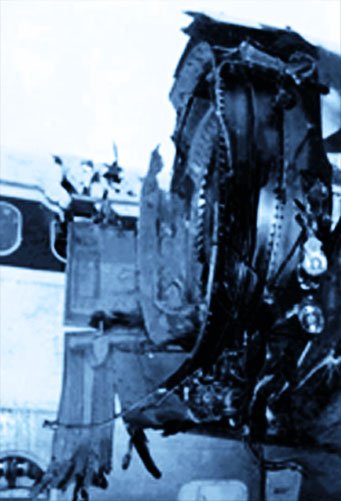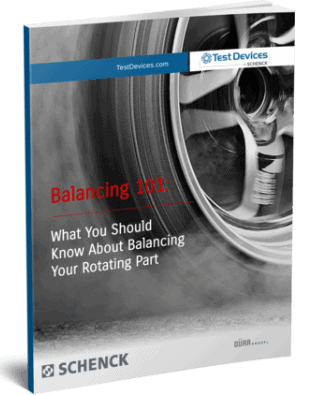Crack Detection
The Issue
The development of high-speed machinery requires extensive testing to establish the useful life of rotating components. The fundamental tool for life assessment is Low Cycle Fatigue (LCF) testing, in which rotating components are cycled from low speed (low stress) to operational speed (high stress) repeatedly for a prescribed number of cycles, at both ambient and elevated temperature gradients. Monitoring the condition of components in real time during LCF testing can provide critical information, especially when a crack initiates, as well as reduce testing downtime for component inspection.
Why it Matters
If not detected, cracks that form in rotating components can lead to component failure, resulting in damage to assets and personal injury. Stopping the test before burst leaves no doubt as to the crack initiation site and allows for precise analysis of the crack face, making it easier to determine root cause. In addition, avoiding burst by detecting cracks that initiate in the tooling or shifting of the tooling components themselves saves the asset for further testing. This eliminates substantial costs that result from lost components, impacted schedules, retesting, and spin chamber repair. (See Figure 1.)
What You Can Do
Test Devices patented* Real Time Rotor Health Monitoring System can detect the initiation of cracks and monitor component and tooling flaws while LCF testing is underway with 80% to 90% accuracy. This substantially reduces the risk of losing the component prematurely and provides a more accurate means of determining initiation sites, failure mechanisms and root cause.The system measures the unbalance vector of the rotating component and compares the amplitude and phase of this unbalance to a previously established baseline. Any distortion in the strain field, or any relative movement of the components of the assembly, will cause a change in unbalance that appears as a very small but detectable vector with a distinct amplitude change. Simple vibration monitoring systems lack the sensitivity required to detect these minute but critical changes.
Test Devices offers Real-Time Rotor Health Monitoring as an option on all LCF tests, and supplies periodic crack detection data to keep the customer informed of the rotor’s health.
* U.S. Patents 6,098,022 and 6,456,945
Advantage of Real-Time Health Monitoring
Reduced Risk of Component Loss: Until the development of Real-Time Rotor Health Monitoring, spin pit LCF tests ended in one of two ways: (1) the rotor under test successfully completed the intended number of cycles, or (2) the rotor burst, leaving little indication of cause other than a bag of shrapnel. With Real-Time Rotor Health Monitoring, Test Devices can halt LCF tests after a crack has formed in the rotor or spin tooling but prior to failure.
Simplified Failure Analysis: Engineers and metallurgists gain an opportunity to determine the crack initiation site with complete certainty and to view a cracked rotor without collateral damage. The crack surface is perfectly preserved, so crack growth rates can be precisely calculated and a more accurate analysis of failure root cause determined. What’s more, time wasted doing “best guess” analysis of destroyed parts is eliminated.
Less Re-Fabricating: Because testing can be stopped before burst, the cost and time for re-fabricating damaged rotor, blades and spin chambers is saved. In many cases these costs can be substantial.
Expedited Testing: Our sophisticated and reliable crack detection method significantly reduces the need for repeatedly interrupting an LCF test for interim NDT inspections, so a complete cycle of test programs is completed sooner.
Crack Detection Value – A Proof Statement
Since the development of our crack detection rotor health monitoring capability, Test Devices has received LCF testing projects that have been diverted from our competition due to persistent rotor and tooling failure.
In one of our most recent instances, a program was shifted from a European competitor to Test Devices because of the loss of several components due to tooling failure. Since Test Devices picked up this project we have stopped multiple tests due to both tooling and component crack initiation. Our capabilities allowed our customer to continue testing of the rotors that would have been lost due to tooling failure and to preserve a cracked component. This led to precise determination of the mode, propagation and root cause of failure.
We are currently in conversations with multiple customers about reducing the number and frequency of inspection cycles during an LCF test because of the reliability of our rotor health monitoring capability.
Applications for Real-Time Health Monitoring
| Jet engine rotors | High-speed fans | High-speed electric motors |
| Centrifuge rotors | Composite flywheels | Industrial gas turbine rotors |
| Turbochargers | Compressor rotors | Material characterization |
| Rocket pumps |

Remote Testing
Remote Testing
Real-Time Rotor Health Monitoring can be installed at a customer’s site and monitored remotely by Test Devices engineers.










